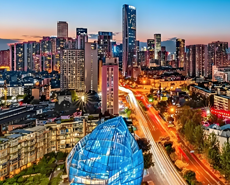
Optimistic on global rare earth demand in the medium and long term
----Interview with Rodrigo Ceballos
CEO
BioLantánidos
CEO
BioLantánidos
Chilean based BioLantánidos focuses on the developing of its Penco rare earth project in Chile. With a mining life of more than 10 years, Penco rare earth project's content of dysprosium and terbium reaches 5.5% of TREO. BioLantánidos plans to finish the new feasibility study of Penco rare earth project in March 2020 and aims to start production at the end of 2022.
Asian Metal: Thanks for receiving my interview, Rodrigo. Please introduce your company firstly.
Mr. Ceballos: Thank you Vivian for offering me this opportunity to discuss rare earth market and our project. BioLantánidos is a Chilean company, which applied itself to the developing of its heavy rare earth project over the past years. In 2019, BioLantánidos was acquired by Hochschild Mining, a London listed company with extensive international experience in precious metals. We have recently strengthened our team with top skilled professionals, as we make good progress on local permits and feasibility study.


Asian Metal: We know that BioLantánidos focused to develop your Penco rare earth project over the past years. Would you please introduce your Penco project briefly?
Mr. Ceballos: As one of the most competitive rare earths projects outside of China, Penco rare earth project is a heavy rare earth project located in Chile. The project is environmentally friendly and rich in dysprosium, terbium, neodymium and praseodymium. The content of dysprosium and terbium accounts 5.5% of TREO. The project also owns low costs structure and full funding.
All this makes Penco rare earth project a highly attractive prospect and a significant player in the heavy rare earth element supply chain. As you can see, we are very excited about what lies ahead. We are developing Penco rare earth project when everybody looks for additional sources of heavy rare earths and clean technologies, which require heavy rare earth element, face increasing pressure.
Asian Metal: May I know why your company decided to develop rare earth project?
Mr. Ceballos: Well, it seems clear that our society faces an increasing need for goods and services related to power generation, transport, communications and electronics and so on. There is little doubt about this. At the same time, our society comes under pressure to provide all these goods in a more sustainable way, which includes reducing our overall environmental footprint, lowering carbon emissions in transport and power generation, minimizing waste disposal, innovating and developing new technologies in that direction.
Rare earth elements become more and more crucial for the production of clean and sustainable energy and mostly related to electric mobility, green power generation and electronics. We believe the demand for rare earth would keep increasing. Rare earth further supply will rely on new viable projects, which are scarce and definitively won't become a reality overnight. This makes assets and resources, like Penco rare earth project, become particularly valuable. We have decided to fully move forward with this project, as it is the only viable, fully funded, ion clays HREE outside of China.
Given this opportunity, we have built a team of strong professionals, who work along with world-class experts in this field. We are putting together internal resources, external private and public institutions, such as University of Concepción, University of Chile and the Chilean Economic Development Agency. We have also made crucial progress securing all the relevant REE-ionic clays potential in the country.

Asian Metal: Markets of neodymium oxide 99.5%min and dysprosium oxide 99.5%min witnessed reducing demand from global buyers over the past months after the outbreak of COVID-19. Would you please share your opinion about demand for these products in the coming months?
Mr. Ceballos: Of course. We believe that the demand for neodymium oxide 99.5%min and dysprosium oxide 99.5%min will remain strong in the oncoming future. The spread of COVID-19 would depress the demand in the coming 6, 10 or 12 months or longer. However, medium and long term fundamentals of these products seem to remain untouched. And why not even stronger demand?
We have clear reasons to think so, based on what's happening with electric vehicles production and demand, onshore and offshore wind power generation projects, government stimulus and incentives to these industries. All these are no longer single-country initiatives, but fully global trends. Moreover, although there has been a specific effect on demand, this pandemic has somehow strengthened the need of an innovation-driven economic recovery, based on cleaner technologies. For instance, governments of the world's top economies, have already committed around US$20 billion funding to support specifically targeting clean technology industries to recover from COVID-19.
Overall, I believe that medium and long term demand of rare earth will clearly exceed the expected rare earths output, especially for magnet production-related products including neodymium and dysprosium.
Asian Metal: Current mainstream prices of neodymium oxide 99.5%min and dysprosium oxide 99.5%min hover at USD41-42/kg and USD267-272/kg. Could you please share your opinion about price trends of neodymium oxide 99.5%min and dysprosium oxide 99.5%min in the near future?
Mr. Ceballos: That's a tough question. It's always hard to forecast prices with reasonable accuracy, especially in the middle of a pandemic, which disrupted the supply chain and is making planning particularly complex. Nevertheless, prices have been dragged by softened demand. On the supply side, mining and separation activities have been depressed by COVID-19 related issues. For example, Lynas temporarily reduced production at its Malaysian separation facility. In my opinion, the majority of rare earth producers have recently adjusted their operation and incorporated new sanitary protection standards.
Besides, there are additional factors to be considered. When looking at recent history, government actions such as duties, subsidies, stockpiling and quotas have strongly shaped the rare earths prices landscape. These measures can target mining production, refining, separation, trading, ultimately demand, and have become key price drivers.
Asian Metal: Dragged by the softening demand from automobile industry, NdFeB magnet market saw decreasing buying activities in the past two months. How do you think about the NdFeB magnet demand in the future?
Mr. Ceballos: I believe that the NdFeB magnet demand will remain strong and healthy in the future. I see basically no signs suggesting that this activity will weaken. As mentioned before, market fundamentals are already there, on top of existing government measures pointing to the same direction.
In my opinion, concerns should come more from the supply side of the magnets sector. Whether we would have sufficient heavy rare earths available to cope with the expected demand? Furthermore, there is an increasing need of a well-diversified supply of these elements. This is when BioLantánidos becomes important, indeed.

















